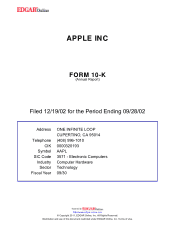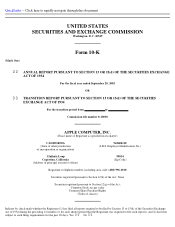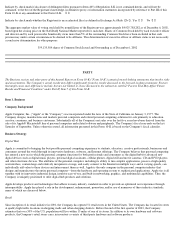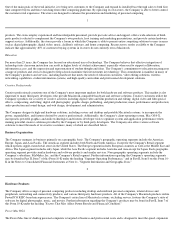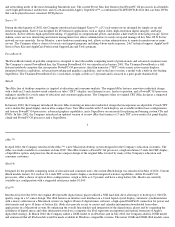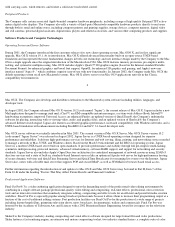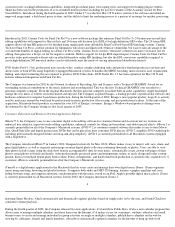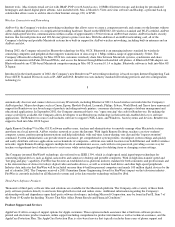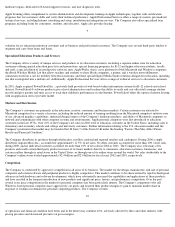Apple 2002 Annual Report Download - page 5
Download and view the complete annual report
Please find page 5 of the 2002 Apple annual report below. You can navigate through the pages in the report by either clicking on the pages listed below, or by using the keyword search tool below to find specific information within the annual report.
and networking needs of the most demanding Macintosh user. The current Power Mac line features dual PowerPC G4 processors in all models,
a new high-performance architecture, and on certain models Apple's SuperDrive™, a combination CD-RW/DVD-R drive that can burn DVDs
that can be played in most consumer DVD players.
Xserve
™
During the third quarter of 2002, the Company introduced and shipped Xserve™, a 1U rack-mount server designed for simple set up and
remote management. Xserve was designed for I/O intensive applications such as digital video, high-resolution digital imagery, and large
databases. Xserve delivers high-speed networking, 15 gigaflops of computational power, and almost a half terabyte of hot-plug storage. Server
Admin, a new services monitoring and remote management tool, allows administrators to easily set up and manage all key Mac OS X Server
network services remotely. Server Monitor, a new hardware monitoring tool, allows system administrators to remotely monitor one or many
servers. The Company offers a choice of services and support programs including 4-hour onsite response, 24x7 technical support, AppleCare®
Service Parts Kits and AppleCare Professional SupportLine and Tools program.
PowerBook
®
The PowerBook family of portable computers is designed to meet the mobile computing needs of professionals and advanced consumer users.
The Company's current PowerBook line, the Titanium PowerBook G4, was introduced in January 2001. The Titanium PowerBook is a full-
featured notebook computer that incorporates PowerPC G4 processors, thin film transistor ("TFT") wide-screen active-matrix displays,
integrated wireless capabilities, advanced networking and graphics capabilities, and on the latest version, a model with a built-in slot-loading
SuperDrive. The Titanium PowerBook G4 is 1-inch thick, weighs as little as 5.4 pounds and is encased in a pure-grade titanium body.
iMac®
The iMac line of desktop computers is targeted at education and consumer markets. The original iMac features innovative industrial design
with a built-in 15-inch shadow-mask cathode ray tube ("CRT") display, easy Internet access, fan-less operation, and a PowerPC G3 processor,
making it suitable for a wide range of education and consumer applications. The Company offers its original CRT iMac design at a suggested
retail price under $1,000.
In January 2002, the Company introduced the new iMac featuring an innovative industrial design that incorporates an adjustable 15-inch TFT
active-matrix flat panel display and an ultra-compact base. New iMac models with 15-inch displays are available in three base configurations
and feature PowerPC G4 processors, advanced graphics capabilities, and a SuperDrive on one model for playing and burning custom CDs and
DVDs. In July 2002, the Company introduced an updated version of its new iMac that features a 17-inch TFT active-matrix flat panel display,
a high-end PowerPC G4 processor, and a SuperDrive.
3
eMac™
In April 2002, the Company introduced the eMac™, a new Macintosh desktop system designed for the Company's education customers. The
eMac was made available to consumers in June 2002. The eMac features a PowerPC G4 processor, a high resolution 17-inch flat CRT display,
a SuperDrive option, and preserves the all-in-one compact design of the original iMac favored by many of the Company's education and
consumer customers.
iBook ®
Designed for the portable computing needs of education and consumer users, the current iBook design was introduced in May of 2001. Current
iBook models feature 12.1-inch or 14.1-inch TFT active-matrix displays, include integrated wireless capabilities, utilize PowerPC G3
processors, offer a choice of optical drive configurations, weigh as little as 4.9 pounds, and have a long battery life. iBooks are currently
available in a configuration with a suggested retail price under $1,000.
iPod™
Introduced in October 2001, the original iPod portable digital music player utilized a 5GB hard disk drive allowing it to hold up to 1,000 CD-
quality songs in a 6.5 ounce design. The iPod features an intuitive user interface on a 2-inch liquid crystal display, automatic synchronization
with a music collection on a Macintosh system via Apple's iTunes ® digital music software, a high-speed FireWire® connection for power and
data transfer and up to 10 hours of battery life. iPods also provide access to contact and calendar information downloaded from other
applications on a Macintosh system. By enhancing the overall functionality and integration of the digital music player and by expanding the
usefulness of digital music and other information stored on a computer, the iPod represents an important and natural extension of Apple's
digital hub strategy. In March 2002, the Company added a 10GB model to its iPod line, and in July 2002, the Company added a 20GB model
and announced that all iPod models would be made available in Windows
-
compatible versions. The newer 10GB and 20GB iPod models come

